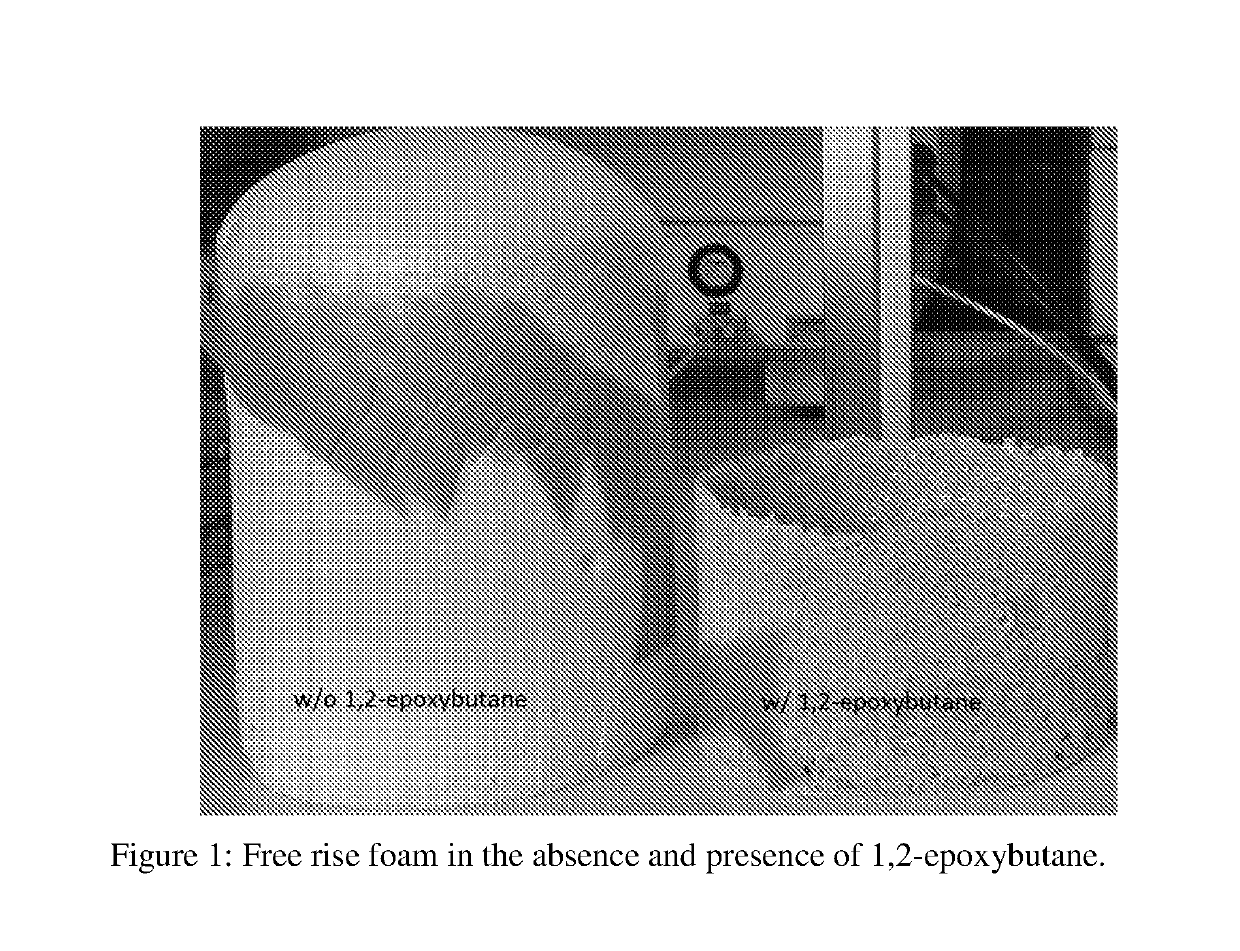Polyol pre-mixes having improved shelf life
a technology of polyol pre-mixes and shelf life, which is applied in the field of polyol pre-mixes having improved shelf life, can solve the problems of difficult pre-mixing of satisfactory thermoset foams using halogenated hydroolefinic materials as blowing agents, poor quality of foam, and even collapse, so as to improve the shelf-life of pre-mixes and/or the quality of thermoset foams
- Summary
- Abstract
- Description
- Claims
- Application Information
AI Technical Summary
Benefits of technology
Problems solved by technology
Method used
Image
Examples
example 1
[0070]The following components, as listed in Table 3, were used: Rubinate® M, a polymeric methylene diphenyl diisocyanate (pMDI), Jeffol® polyols and Jeffcat® catalysts are available from Huntsman; Jeffol® R-425-X, a polyol from Huntsman; Voranol® 490, a polyol from Dow; Stepanpol® PS-2352, a polyol from Stepan Company; Tegostab® B8465, a surfactant available from Evonik-Degussa; Polycat® catalysts from Air Products; tris-(chloroisopropyl) phosphate (TCPP), a flame retardant, from ICL-IP America. Cyclohexene oxide was purchased from Aldrich Chemicals. The formulations tested all had an Iso Index of approximately 114.
TABLE 3Formulation using trans-1233zd and cyclohexene oxidewt % B-sideFormulationExample 1Example 2Voranol ® 49037.2136.67Jeffol ® R-425-X22.5022.17Stepanpol ® PS 235215.1314.91Tegostab ® B 84651.501.48TCPP4.984.90PolyCat ® 50.280.28PolyCat ® 80.920.92Water1.481.46Cyclohexene oxide01.20Trans-1233zd16.0016.00Total100.00100.00
Using both formulations, normal foams were obta...
example 3 and 4
[0072]The formulations of Examples 1 and 2 were aged at 50° C. for 7 and 14 days respectively. Hand-mixed foams were made; their reactivities were measured and are summarized in Table 5.
TABLE 5Example 3Example 4Reactivity change (%)7 days14 days7 days14 daysCream time+70+110+36+64Gel time+42+58+32NA*Tack free time+42+68+21NA**Foam quality was sufficient to measure
[0073]With addition of cyclohexene oxide, an improvement of aged reactivity was observed (i.e., the formulation containing cyclohexene oxide exhibited greater stability on aging than the formulation without cyclohexene oxide).
examples 5 and 6
[0074]1H NMR experiments were performed at 25° C. using a Bruker Avance III 500 (11.7 T) equipped with a 5 mm 1H / 19F / 13C TXO probe. Aliquots of bulk phase samples were taken from chilled test tubes and diluted in 0.5-1 mL CDCl3 to make 1-5% (v / v) concentration. A quantitative method was established, to measure the extent of acidification of amine catalysts resulted from aging, by measuring the deshielding (downfield shift) of —NCH3 peak of PC8 in 1H NMR, in comparison to the fresh blend, as listed in the last column of Table 1. A peak shift less than 0.01 ppm (5 Hz for 500 MHz NMR) is considered negligible. Peaks were referred to the main signal of —CH2Cl (1.7 ppm) of TCPP (flame retardant), therefore, peak shift was corrected accordingly.
[0075]FIG. 2 shows that in the absence of cyclohexene oxide, PolyCat® 8 (PC8) was progressively acidified as it was aged.
[0076]FIG. 3 shows that in the presence of cyclohexene oxide, the position of PolyCat® 8 (PC8) was relatively unchanged, indica...
PUM
| Property | Measurement | Unit |
|---|---|---|
| boiling points | aaaaa | aaaaa |
| wt % | aaaaa | aaaaa |
| wt % | aaaaa | aaaaa |
Abstract
Description
Claims
Application Information
 Login to view more
Login to view more - R&D Engineer
- R&D Manager
- IP Professional
- Industry Leading Data Capabilities
- Powerful AI technology
- Patent DNA Extraction
Browse by: Latest US Patents, China's latest patents, Technical Efficacy Thesaurus, Application Domain, Technology Topic.
© 2024 PatSnap. All rights reserved.Legal|Privacy policy|Modern Slavery Act Transparency Statement|Sitemap



